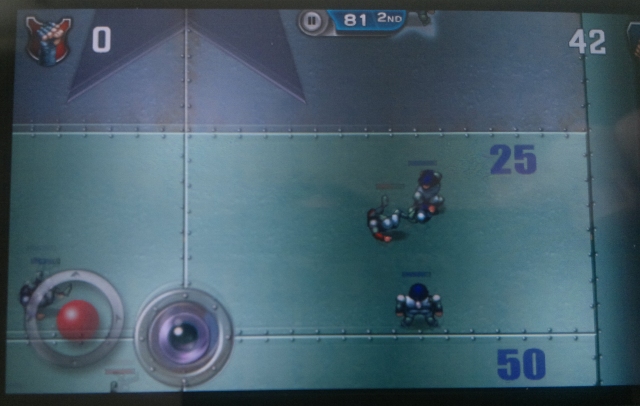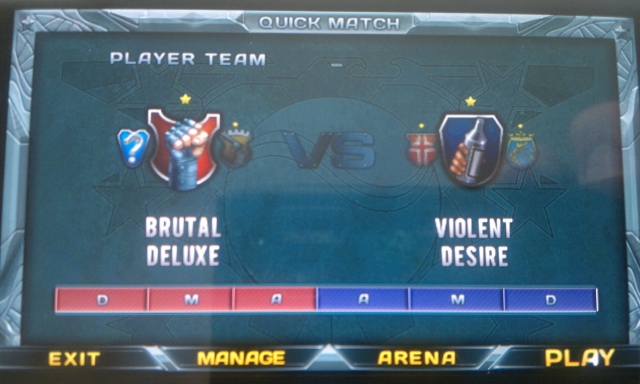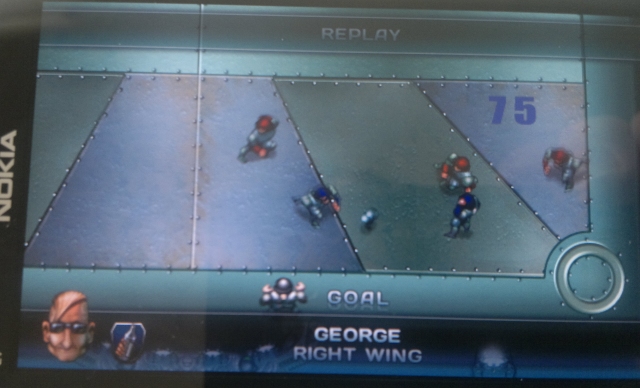Review: Speedball 2 Evolution
Score:
88%
Ah, Speedball 2. It's a name that is spoken of in reverential terms, because of the impact that it had on the computer gaming world in the late 80s and 90s. Now two of the original Bitmap Brothers, as part of Tower Studios, have updated the classic futuristic sports game for Symbian. Have they captured enough of the spirit of the original to make Brutal Deluxe a watchword for smartphone fun? Let's find out.
Buy Link | Download / Information Link
First up, don’t bother looking for Speedball – historians will know that this is a game from 1989 that flooded the minds of Atari ST and Commodore Amiga owners. The next version, Speedball 2: Brutal Deluxe sealed the reputation of the franchise, and that meant that pretty much every sequel was prefixed Speedball 2.
Now here’s Speedball 2 Evolution, a licenced version of the game that’s made the jump to the smartphone world via Tower Studios. Anyone who has memories of the game needs to know only one thing. This is Speedball 2, as you remember it, but in your pocket. Go buy it now.

And now, for everyone else. Speedball 2 is essentially a souped up, science fictionalised version of a contact ball sport – think Rugby, American Football, Rollerball and British Bulldog all rolled into one. You have a team of nine cyborgs (human players with mechanical improvements, so they don’t feel pain, for example), and your goal is to score more points than the opposing team. The easiest way is to throw the ball into the opponents goal (that would be ten points) but there are stars and bumpers you can hit all around the playing field, just like a pinball machine has, for smaller scores – but they all add up.
I’d seriously urge any player to go for the tutorial option when they first play the game – it explains the basics and lets you try out the d-pad or tilt controls before you get thrown into a match.
As for all the tackling, passing and jumping moves, you just need to tap the screen in a form of “go do something” and your players will work it out for you. There’s some smart coding here, because I never spotted a moment where I wanted one thing and the controlled player did something else – although the game is fast moving enough that my focus could have already moved on.
It is fast, and for me that means the D-pad is the only way to go. After a few low level opponents are beaten, and you progress through the the ten years of league and cup competitions in the Career mode, there’s just too much you need to be doing to make the accelerometer based tilt control anything other than a hindrance. Interestingly, I can also use the cursor keys and space bar on the E7, but you really need to be able to run and throw diagonally, so Up/Left/Space as a key-press is just too fiddly for my fingers. (Oh for a good old-fashioned 'redefine keys' so Q,A,O,P,Space could be used).

And while the game is fast to play, your cyborg players aren’t sprinter fast and do take some time to move around the screen. That slower pace of the players means that the emphasis is on moving the ball around (the clue, naturally, being in the name) both to pick up little points as you advance to the opponent's goal, but also to find the players in open spaces that give you scoring opportunities.
Alternatively, you could just set up your team to be a big hulking bully and roughly tackle every opposing player to the ground, sneaking in just enough points to stay ahead. The beauty of Speedball is that the tactical choices are as flexible as those on offer in other sports games such as Pro Evolution Soccer.
It’s also super easy to see who’s on which team and what’s going on, mostly because very little has changed between the 16-bit version of the game from the 80’s and now. That means graphical decisions made back then are just as relevant now (given the Amiga had around 640 pixels of width to play around with), and the controls available then (essentially a one button joystick) transfer well to the mobile platform.

Basically, this is as direct a port as you are likely to see, and it’s all the better for it. There’s no need for 3D versions, extra graphics or tweaks, it worked then, and it works now. People new to the sport may wonder why the directional control is limited to 8 way, and not a fully analogue system (which could, in theory be done) and the answer is pretty simple. Because it works.
It's exactly the same with the sound. The crisp sound of metal on metal tackles, the roar of the crowd, all lifted from the original (yes, even the call of "Ice Cream" from the sellers in the crowd). Never getting in the way, always adding to the gameplay, and adding a physicality to the tackles - the sound design still works some twenty years later.
Around the core game, you have a quick-play option which lets you simply play one game at a time, just for the fun of it. But the big, long-term option is the already mentioned career option which sees you lead a team (you know you’re going to call them Brutal Deluxe!) through ten years of competition, managing the team and also scouting for new players – it’s a very, very basic management sim, but enough to give you an emotional bond with your team.
The only disappointment is the lack of a multi-player mode in the game. Even a local Wi-fi-enabled option to play your friends would have lifted this up to a 90 score. As it stands, it’s very much recommended, with two caveats. The first is that it genuinely plays and handles like a game from the nineties and you’ll need to decide if you can live with that (I can). The second is that the smaller screened Symbian^3 devices (like the C6-01) are perhaps a little bit cramped when you play the game.
-- Ewan Spence, April 2011.
Reviewed by Ewan Spence at
